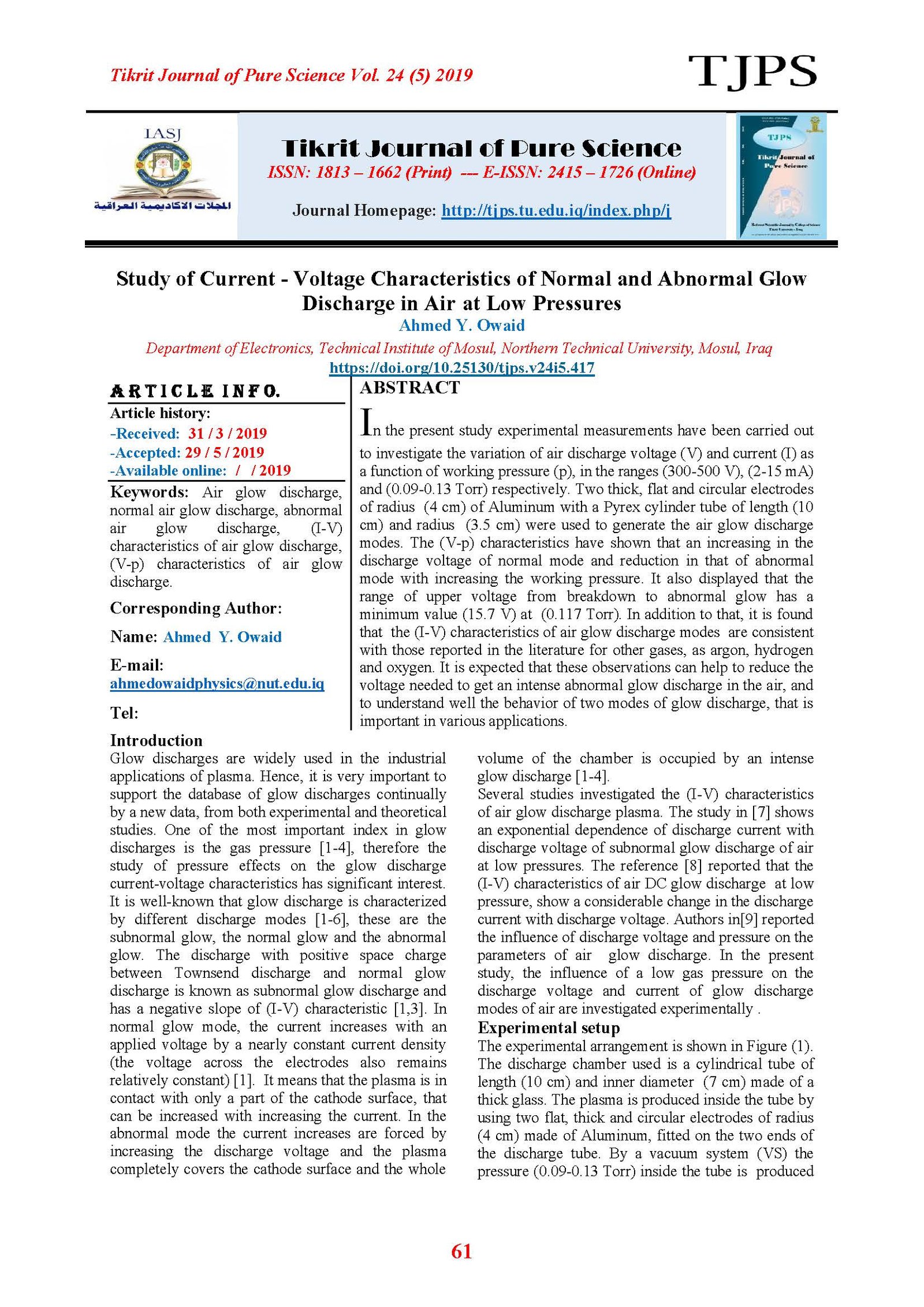Study of Current - Voltage Characteristics of Normal and Abnormal Glow Discharge in Air at Low Pressures
Main Article Content
Abstract
In the present study experimental measurements have been carried out to investigate the variation of air discharge voltage (V) and current (I) as a function of working pressure (p), in the ranges (300-500 V), (2-15 mA) and (0.09-0.13 Torr) respectively. Two thick, flat and circular electrodes of radius (4 cm) of Aluminum with a Pyrex cylinder tube of length (10 cm) and radius (3.5 cm) were used to generate the air glow discharge modes. The (V-p) characteristics have shown that an increasing in the discharge voltage of normal mode and reduction in that of abnormal mode with increasing the working pressure. It also displayed that the range of upper voltage from breakdown to abnormal glow has a minimum value (15.7 V) at (0.117 Torr). In addition to that, it is found that the (I-V) characteristics of air glow discharge modes are consistent with those reported in the literature for other gases, as argon, hydrogen and oxygen. It is expected that these observations can help to reduce the voltage needed to get an intense abnormal glow discharge in the air, and to understand well the behavior of two modes of glow discharge, that is important in various applications.
Article Details

This work is licensed under a Creative Commons Attribution 4.0 International License.
Tikrit Journal of Pure Science is licensed under the Creative Commons Attribution 4.0 International License, which allows users to copy, create extracts, abstracts, and new works from the article, alter and revise the article, and make commercial use of the article (including reuse and/or resale of the article by commercial entities), provided the user gives appropriate credit (with a link to the formal publication through the relevant DOI), provides a link to the license, indicates if changes were made, and the licensor is not represented as endorsing the use made of the work. The authors hold the copyright for their published work on the Tikrit J. Pure Sci. website, while Tikrit J. Pure Sci. is responsible for appreciate citation of their work, which is released under CC-BY-4.0, enabling the unrestricted use, distribution, and reproduction of an article in any medium, provided that the original work is properly cited.
References
[1] Raizer, Y. P. (1991). Gas discharge physics. springer, Berlin, Germany: 8-25 pp.,35-37 pp.,167-185 pp.
[2] Chapman, B. (1980). Glow discharge processes. Willey, New York: 77-106 pp.
[3] Howatson, A. M. (1976). An Introduction to gas discharges. 2nd edn., Pergamon Press Ltd: 85-102 pp.
[4] Braithwaite, N. St. J. (2000). Introduction to gas discharges. Plasma sources Science Technology, 9 : 517-527.
[5] Bogdanov, E. A.; Demidov, V. I.; Kudryavtsev, A. A. and Saifutdinov, A. I. (2015). Is the negative glow plasma of a direct current glow discharge negatively charged. Physics of plasmas, 22 (024501): 1-4.
[6] Kulkarni, S. V.; Panchali, D.; Kumari, V. and Bora, D. (1996). Characteristics of abnormal glow discharge. IEEE International Symposium on electrical insulation, 2:789-792.
[7] Pradhan, S. S. (2016). Characteristics of subnormal glow discharge in longitudinal magnetic field in air. journal of physical sciences, 21: 139-144.
[8] Lisovskiy, V. A. and Yakking, S. D. (2000). Experimental study of a low pressure glow discharge in air in large diameter discharge tube station. Plasma Physics Resort, 26 (12):1066-1075.
[9] Shrestha, A. K. etal. (2014). Influence of discharge voltage and pressure on the plasma parameters in a low pressure dc glow discharge. International journal of recent research and review, 7 (2):9-15.
[10] Wissel, S.; Zwicher, A.; Ross, J. and Gershman, S. (2013). The use of DC glow discharges as undergraduate educational tools. American Journal of Physics, 81 (9):663-669.
[11] Lisovskiy, V. A.; Artushenko, K. P. and Yegorenkov, V. D. (2016). Normal mode of DC
discharge in Argon, Hydrogen and Oxygen. Problem of atomic science and technology, 22 (6): 223-22.
